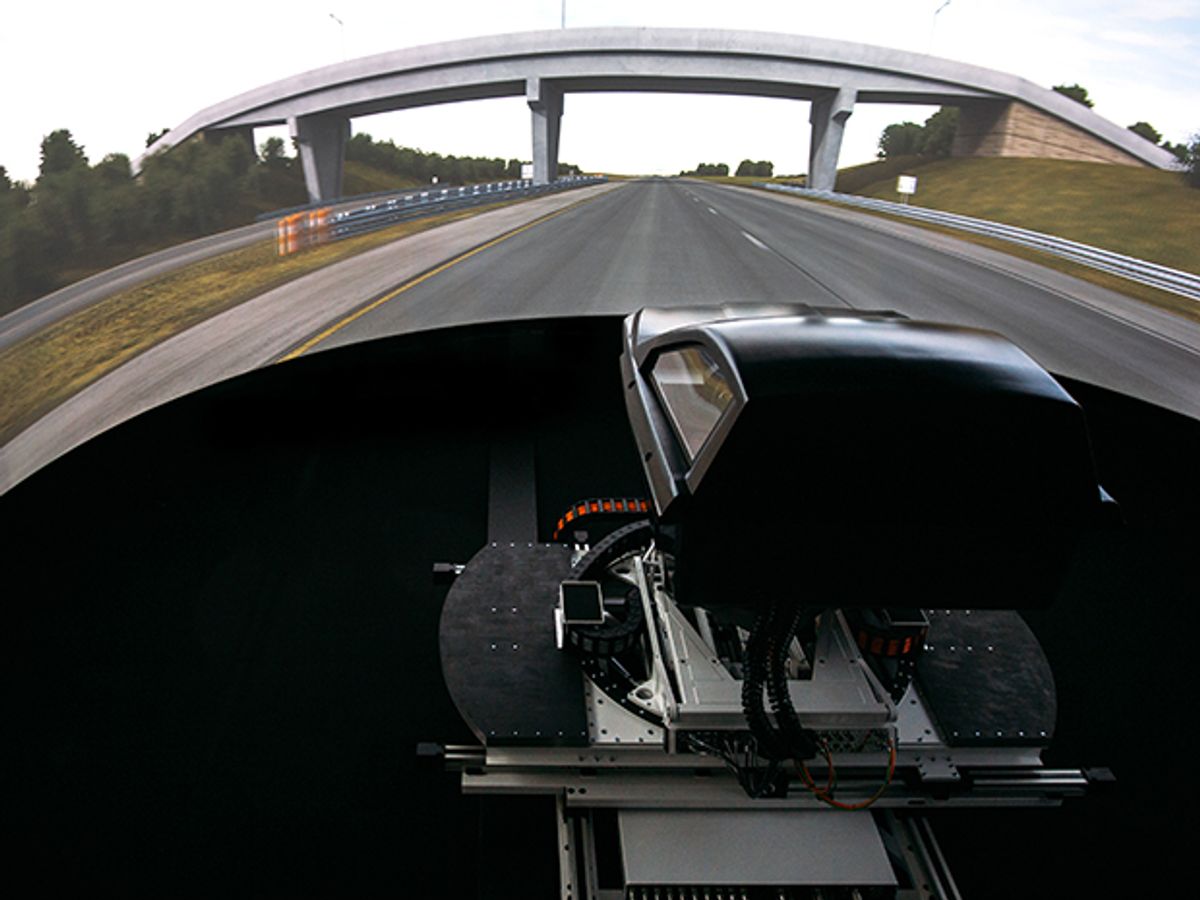Driving simulators that fool only most of your senses most of the time can make you sick to your stomach, particularly when you’re pushing your virtual car to its limits, as test drivers must do.
“A really good human-factors driving simulator might have a 90-millisecond delay, or 0.09 second, and even that’s enough to upset a professional driver,” says Phil Morse, a mechanical engineer who works for Ansible Motion, a simulator company based in Norwich, Britain. “They feel it in a different way than common drivers, just as a professional musician might experience a concert in a different way than the general audience.
“You, too, might notice that latency in certain circumstances,” he adds. “Turn the wheel really fast, and you might be disturbed by the way the scenery is moving past; you might very well get motion sickness.”
Such nausea comes when the senses keep on providing information that’s a little out of synch with expectations. To avoid it, Ansible Motion’s simulators shave the latency period to under 30 milliseconds, short enough to seem like no time at all. Hence the name “ansible,” which is a sci-fi term for a gadget that communicates instantanteously—say, to another galaxy.
There are other industrial-strength simulators out there, including some that cost upwards of US $50,000. But Ansible Motion’s recently released Delta series goes for around $3 million.
Delta’s selling point is that it uses an architecture that’s compact yet capable of moving a test cockpit through all six degrees of motion in a way that’s more efficient than in the older, “hexagonal” architecture, Morse explains. Those six degrees consist of three axes for position—up and down, left and right, back and forth—and three for rotations around those same three axes.
“The actuators are configured in parallel, so you have to move them all to make a single motion in a single direction, so you’re commanding a lot of actuators to do a single task without having a lot of authority over them,” he says. “Look, the ideal way to push a lawnmower is straight, but you need an angled arm—a compromise—if you want to stand upright while you do it.”
But Ansible Motion’s architecture is layered so that the axes of control and the axes of the actuators are more closely aligned. “If I want to move side to side, I have one actuator that does that—not six actuators,” Morse says.
That—and a network of 16 PCs to provide mammoth computing power—shortens latency, which is half the battle. The other half is making the professional driver feel that everything is just as it would be on the road while testing, say, a new emergency braking system, or a lane-changing feature. Low latency times aren’t enough; you also have to fool the driver’s senses with what’s called motion cueing.
Reason: Some things can’t be simulated. Driving down the road for a mile can’t be represented directly even by simulators that put the driver’s cockpit on rails that run from one end of a warehouse to another. Yes, such simulators exist: The U.S. National Highway Transportation Safety Administration has one in Iowa that cost $50 million.
“So we exaggerate the graphics and produce the feeling of taking off by giving a small stimulus, moving the cockpit just half a meter at most,” Morse says. “The driver gets the feeling he’s moved a lot farther. We trick the eyes, we trick the hands with haptics on the steering wheel, we trick the body with the pull of the seatbelt. We trick the vesibular system.”
That’s the inner ear—the mother of all carsickness.
The Delta series has a wraparound screen 8 meters in diameter, which defines the space it takes up. You need some overhead space, as well, for the projectors, and a control room behind the driver, so the operators can see what the driver’s seeing.
At least two racing teams have used Ansible Motion simulators (though not the latest Delta series): Ford Motor Company’s NASCAR operation and the Caterham Formula One team. But the real business lies in validating the human-to-machine interface in the thousands of scenarios that any new driver-assistance technology would entail.
Only when that virtual validation is complete will automotive engineers commit their company to building an actual prototype vehicle, for a pro driver to test on actual roads.
Philip E. Ross is a senior editor at IEEE Spectrum. His interests include transportation, energy storage, AI, and the economic aspects of technology. He has a master's degree in international affairs from Columbia University and another, in journalism, from the University of Michigan.



